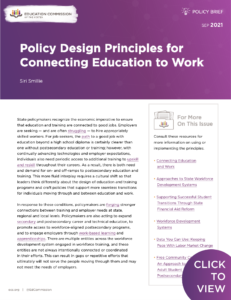State policymakers recognize the economic imperative to ensure that education and training are connected to good jobs. Employers are seeking — and are often struggling — to hire appropriately skilled workers. For job seekers, the path to a good job with education beyond a high school diploma is certainly clearer than one without postsecondary education or training; however, with continually advancing technologies and employer expectations, individuals also need periodic access to additional training to upskill and reskill throughout their careers. As a result, there is both need and demand for on- and off-ramps to postsecondary education and training. This more fluid interplay requires a cultural shift so that leaders think differently about the design of education and training programs and craft policies that support more seamless transitions for individuals moving through and between education and work.
To support state policymakers on this issue, Education Commission of the States, with the support of Strada Education Network, engaged education and workforce leaders in 2019 and again in 2021 to develop and refine four principles of policy design for connecting education to work. This paper details each and shares current examples from states.



